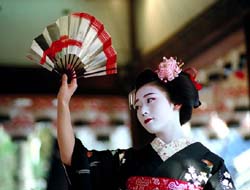





 I recently had the pleasure of meeting a woman who was once the No.1 geisha in Japan. She's a wonderful lady, funny, warm and kind. She was once a favorite of my wife's grandfather who, with his many business and social connections, helped her find sponsors and make her name. He died many years back and more recently his wife - my wife's grandmother - also passed away. This lady unassumingly took control of all the everyday things at home - cooking, cleaning, child-minding - so that the family could grieve and deal with the multitude of funeral related matters. In the evening she regaled us with geisha tales and parlor tricks. Some of the jokes and songs were surprisingly risque, but related with such grace and skill that no one could really be offended. She is well into middle age but I could see how, in her time, she must have drawn men to her like moths to a flame.
I recently had the pleasure of meeting a woman who was once the No.1 geisha in Japan. She's a wonderful lady, funny, warm and kind. She was once a favorite of my wife's grandfather who, with his many business and social connections, helped her find sponsors and make her name. He died many years back and more recently his wife - my wife's grandmother - also passed away. This lady unassumingly took control of all the everyday things at home - cooking, cleaning, child-minding - so that the family could grieve and deal with the multitude of funeral related matters. In the evening she regaled us with geisha tales and parlor tricks. Some of the jokes and songs were surprisingly risque, but related with such grace and skill that no one could really be offended. She is well into middle age but I could see how, in her time, she must have drawn men to her like moths to a flame.
Arthur Golden's 1998 novel Memoirs of a Geisha revived interest in an aspect of Japan that is so intrinsic to the Western stereotype and yet so far removed from the reality of daily life here. Geisha do still exist and ply their trade, of course. But the role they play in modern society is minor and, except for the attention they get from camera-wielding tourists, largely unseen. In fact, most of the women captured on film are either maiko (apprentice geisha) or tourists themselves, done up for a few hours of faux sophistication and attention seeking.
But like their male counterpart the samurai, the geisha and her world continue to fascinate people around the world as part of their image of a mysterious and timeless Japan. Prostitution is of course referred to as the "oldest profession," and the history of the geisha stretches back several centuries. But while many people assume that geisha is just a Japanese word for a prostitute, the somewhat more romantic word 'courtesan' is probably closer in nuance, though even that is misleading when you consider their history. The word geisha itself literally means 'person of the arts' - indeed the earliest geisha were men - and it is as performers of dance, music and poetry that they actually spend most of their working time.
The two most famous hanamichi (geisha quarters) can be found in the capital cities of today and yesteryear, Tokyo and Kyoto. Medieval Edo, as Tokyo was formerly known, had the Yoshiwara pleasure quarters, where kabuki actors and artists would mingle with the evolving merchant class. The Edo period (1600-1868) was a time when Japan was largely closed to the outside world and also an era of great cultural development. Actors, sumo wrestlers and geisha were often the subjects of colorful ukiyo-e, woodblock prints whose name literally means 'pictures of the floating world,' a wonderful euphemism for the world of carnal desires.
In the case of Kyoto, entertainment was to be found in the Shimabara district. Even today, geiko, as they are referred to in Kyoto, and maiko entertain customers in traditional teahouses.
No comments:
Post a Comment